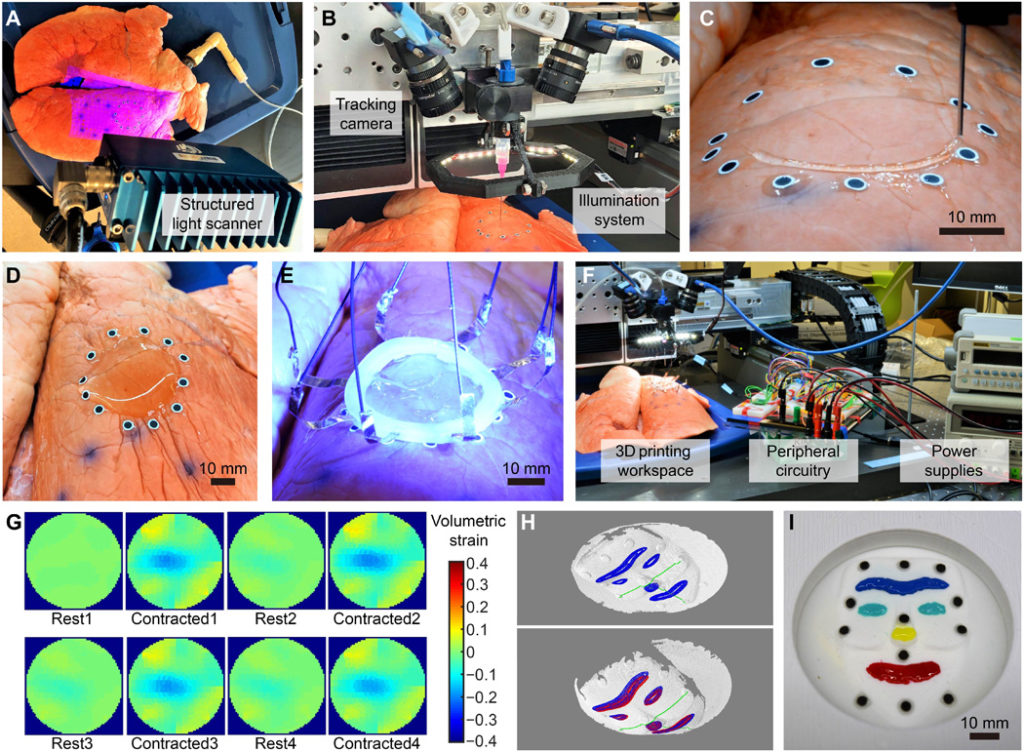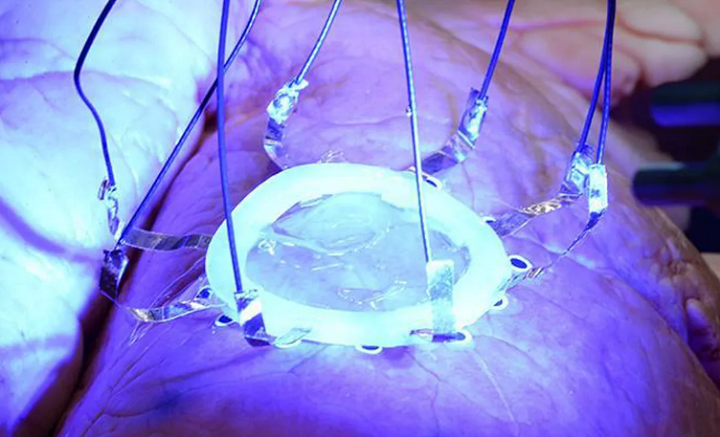A team of researchers from the University of Minnesota has announced some amazing new research that uses “a visual sensing system” (motion capture technology) to print soft, electronic sensors directly onto moving organs. Their technique, which they explain in more detail in a published paper, makes it possible to fabricate these deformable sensors onto organs that are actively expanding and contracting.
The abstract states, “We developed an in situ 3D printing system that estimates the motion and deformation of the target surface to adapt the toolpath in real time. With this printing system, a hydrogel-based sensor was printed on a porcine lung under respiration-induced deformation. The sensor was compliant to the tissue surface and provided continuous spatial mapping of deformation via electrical impedance tomography. This adaptive 3D printing approach may enhance robot-assisted medical treatments with additive manufacturing capabilities, enabling autonomous and direct printing of wearable electronics and biological materials on and inside the human body.”

3D printing on a porcine lung for in situ monitoring of deformation and 3D printing on a deformable phantom face. (A) 3D scanning of the porcine lung with a structured light 3D scanner. (B) Photograph of the custom 3D printing gantry system. (C) Photograph of in situ 3D printing of hydrogel ink on a porcine lung. (D) Photograph of 3D printed circular layer of hydrogel. (E) UV light curing of the hydrogel layer with silicone ring and embedded electrodes. (F) Photograph of hardware setup for in situ monitoring of lung deformation with printed EIT sensor. (G) Spatiotemporal mapping results of 2D-VS within the ROI on a porcine lung undergoing cyclic contraction. (H) Projection of the toolpath (blue) on the 3D scan of the base shape (upper), and projection of the toolpath with (blue) and without (red) shape correction on the 3D scan of a deformed shape of the phantom face (lower). (I) Photograph of 3D-printed eyebrow, eyes, nose, and mouth on the phantom face with multicolored silicone inks. (Photo credit: Z.Z., University of Minnesota)
“We are pushing the boundaries of 3D printing in new ways we never even imagined years ago. 3D printing on a moving object is difficult enough, but it was quite a challenge to find a way to print on a surface that was deforming as it expanded and contracted,” said Michael McAlpine, a UMN mechanical engineering professor and senior researcher on the study.
McAlpine leads the UMN McAlpine Research Group, and he’s been working on 3D-printed sensors for use in medical applications for quite some time. His team was the one that 3D printed sensors directly onto the skin of a moving hand, and has obviously taken their work to the next level.
This new research began with a specialized 3D printer and a balloon-like surface standing in for the moving organ. Then, the researchers placed motion capture tracking markers, similar to those used for special effects in films, onto the balloon. These markers actually help the machine adjust its print path to the surface’s expanding and contracting movements, tracking the placement of a deformable sensor during the printing process. Once they successfully printed a hydrogel-based sensor on the surface, they moved on to something even more lifelike: printing a soft sensor on the lung of a pig that was artificially inflated in order to mimic breathing.
While work is still in the early stages with this technique, the researchers think it could be adapted for use both inside and outside of the body. McAlpine hopes that, in the future, this breakthrough technology can be used to 3D print medical sensors on other tissues of living patients, like a beating heart, to improve wound treatment, patient monitoring, and even diagnose medical conditions, such as COVID-19.

The deformable 3D-printed sensors can move along with expanding and contracting organs like lungs. (Image credit: McAlpine Research Group, University of Minnesota)
“The broader idea behind this research, is that this is a big step forward to the goal of combining 3D printing technology with surgical robots. In the future, 3D printing will not be just about printing but instead be part of a larger autonomous robotic system. This could be important for diseases like Covid-19 where health care providers are at risk when treating patients,” McAlpine said.
Check out the amazing video below to get an up close and personal look at the 3D printed deformable sensor in action, being 3D printed onto the porcine lung.
Back in 2017, when the live-action version of Beauty and the Beast came to movie theatres, I saw a press photo showing Emma Watson (Belle) and Dan Stevens (the Beast) filming the iconic scene where Belle enters the ballroom in her yellow dress, and the Beast meets her. In the photo, Stevens is not wearing fine clothes, but rather a strange puffy gray suit, with odd black and white marks all over it, that covered his entire torso down to his feet, with a matching cap on his head. It wasn’t a fashion statement, but a way to record his movements and later use the information to animate a digital model of the Beast.
This amazing technology is called motion capture, and while it’s been used in conjunction with 3D printing before, I never thought it had any use with medical applications. It turns out that I was wrong.
Discuss this news and other 3D printing topics at 3DPrintBoard.com or share your thoughts in the Facebook comments below.
Subscribe to Our Email Newsletter
Stay up-to-date on all the latest news from the 3D printing industry and receive information and offers from third party vendors.
You May Also Like
3D Printing Unpeeled: New Arkema Material for HP, Saddle and Macro MEMS
A new Arkema material for MJF is said to reduce costs per part by up to 25% and have an 85% reusability ratio. HP 3D HR PA 12 S has been...
3D Printing News Briefs, January 20, 2024: FDM, LPBF, Underwater 3D Printer, Racing, & More
We’re starting off with a process certification in today’s 3D Printing News Briefs, and then moving on to research about solute trapping, laser powder bed fusion, and then moving on...
3D Printing Webinar and Event Roundup: December 3, 2023
We’ve got plenty of events and webinars coming up for you this week! Quickparts is having a Manufacturing Roadshow, America Makes is holding a Member Town Hall, Stratafest makes two...
Formnext 2023 Day Three: Slam Dunk
I’m high—high on trade show. I’ve met numerous new faces and reconnected with old friends, creating an absolutely wonderful atmosphere. The excitement is palpable over several emerging developments. The high...

































